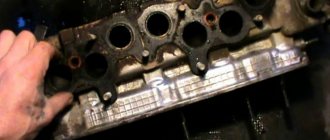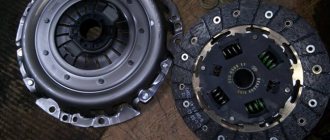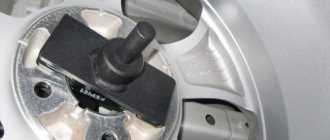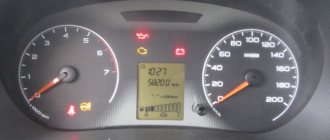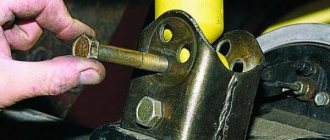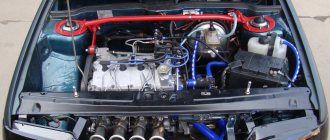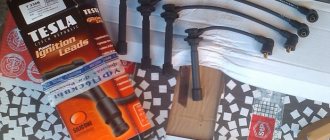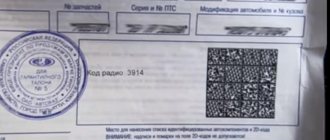Where to look for the body number and VIN
The VIN code consists of a certain combination of Arabic numerals and the Latin alphabet, which cannot be altered. When creating, manufacturers use a calculation algorithm accepted by most countries. Therefore, using the number, it is easy to see through electronic services whether the car is on the wanted list.
When creating an identifier, it is prohibited to use the letters of the Latin alphabet Q, I, O: O can be confused (or converted) into the letter Q, and the letters I and O duplicate the numbers 0 and 1.
The number is included either in the vehicle registration certificate or in the registration certificate. Sometimes both documents have a corresponding (same) paragraph. On the car itself, the VIN code can be found on the chassis, integral parts of the body, plates (nameplates):
- instrument panel on the left (code visible through the windshield);
- front left pillar;
- cylinder block, cylinder head;
- door sills;
- spars;
- engine compartment - plate with number;
- under the driver's seat: the numbers are visible if the seat is moved.
Technical documents for the car indicate all the places where the identification number is stamped.
The American manufacturer uses for marking part of the dashboard on the driver’s side, the driver’s door opening, where a special sticker with a number is installed.
Car release date via VIN
In the VIN code, manufacturers are not required to indicate the place of assembly of the vehicle, but the production date is required. Companies do not indicate the year of car production, which coincides with the calendar year, but the model year. It starts on July 1 and lasts up to 18 months if the car does not go into production.
The model date is indicated by the following corporations:
American manufacturers, when organizing a premiere show of a new model, set the date for the series to go on sale, i.e. the next one.
You can quickly find out the year of manufacture of a car by VIN by learning the rules for reading the license plate. The output is indicated in the 10th position, for some American brands in the 11th position, the month in the eleventh, for “Americans” in the 12th position.
The number indicates the last digit of the year for cars manufactured from 1971 to 1979, followed by 20 Latin letters in order (except for those excluded) for cars manufactured from 1980 to 2000. Then the frequency is repeated. If the number 1 is in the tenth place of the number, then the car came off the assembly line either in 1971 or 2001. If the letter D is indicated, then in 1983 or 2013.
The classification is based on common sense: a motorist can easily distinguish a car that is 5 years old from a model that is thirty-five years old.
You can check your car online. There are enough services on the Internet that provide such a service. If you submit an official request to the traffic police website, the VIN code will determine when the car was manufactured, specify the number of owners, the status of the car, etc.
Extracting engine information from VIN code
As can be seen from the above, the VIN code itself does not indicate the model and engine number. How can you recognize them, for example, in order to check the “cleanliness” of a car purchased second-hand?
Let's look at several manufacturers and what you can find out about the engine using the VIN code.
- AUDI - the car has a European standard VIN. Using the code, you can find out the manufacturer, for which markets the modification was made, model, assembly plant, serial number, etc. Knowing the exact model of the car, you can find out the type of installed power unit.
- FORD - the VIN code indicates the manufacturer, body type, location of production, model, month and year of production. Just as in the case of AUDI, you can find out the engine brand by the car model.
- Volkswagen - also, by looking at the VIN you can find out the year of manufacture and model, and using this information you can determine what model of engine is installed in this car.
- Mitsubishi - these cars have more information hidden in the VIN. It indicates the manufacturer's code, what type of body, what gearbox, model, engine code, type of car, year of production, production plant, serial number. By the engine code you can determine the type and displacement. To understand, if a Lancer has the number 5 in its engine code, this means that it has a 4G93 engine with a volume of 1834 cm 3 installed.
- BMW - the code indicates the car model, year of manufacture, and, based on this data, you can find out the engine type.
- Toyota - in the VIN code of these cars, the sixth digit indicates the series of installed engines. The rest of the data is the same as that of other automakers - place of production, body, model, serial number.
- Opel - on these cars both the car model code and the engine code are indicated.
- Skoda - in Skoda, the engine type is indicated by the fifth letter in the VIN code.
Thus, we can conclude that finding out the number of the installed engine using the VIN code is very problematic. From it you can only find out the modification and type of engine. If you really need to find out the engine number, you can turn to sites that offer services to provide information based on the data specified in the VIN code, but obtaining the information will cost a certain amount.
You can contact the dealer, and he, by contacting the manufacturer, can provide information on the car’s configuration with license plate units, but this will take some time and it is not a fact that the dealer will be ready to provide such information for free.
By the way, for many foreign manufacturers, the engine is not a numbered part, but the number printed on it is actually a technological number and is only needed during assembly of the car.
When purchasing used cars, few people check the engine model
And this is important to do, since in the future there may be problems with repairs - the spare parts that you will buy for the factory engine simply will not be suitable for the engine replaced during operation. Another possible problem is that the vehicle has been stolen and the engine numbers have been altered.
In this case, there may be discrepancies with the documents. Therefore, before purchasing a used vehicle, you must find out the engine model by VIN code.
Find out when a machine leaves the assembly line by the stamp of its components
You can quickly find out the production period of a car using the markings of components. However, this is a bad way to check if you need to buy a car second-hand: all removable parts, including the windshield, can be replaced with new ones.
Windshield
Windshield manufacturers always mark the part in accordance with international standards. When branding glass, any form of numbering can be used, but the principle always remains: the year is marked with a number from 0 to 9 and the month with a letter or the exact number of dots or asterisks. In a sign combination, the symbols are used in any sequence (depending on the manufacturer’s certificate).
Determining the year of manufacture of a windshield is simple: first the year is marked, then three (less often more) letters. The first letter corresponds to the month of issue.
for marking glass, I assigned the second letter of the English alphabet for the first month, shifting the order of reading the mark by one position.
To make sure that the month of manufacture of the car matches the brand on the windshield, you need to check all the VIN codes on the body.
Safety belt
This is the second element by which you can check the date of manufacture of the car, provided that the stamp that some manufacturers put with stamped paint has not been erased.
A manufacturer's label is attached to the bottom of the belt, where the production date is written. The lower, and less often the upper, clamps should also be marked. The calendar date of production is stamped on the parts.
When checking belts as a VIN identifier, it is necessary to take into account that when assembling in a broken cycle, when components are brought to the assembly line from different companies, the date of manufacture of the belt may not coincide with the final year of production of the car.
Shock absorber struts
Checking the shock absorber struts of the trunk and hood will tell you a lot about the car, but only if the car was assembled in Europe after 1997. Two numbers separated by a fraction are stamped on the racks. The first digit represents the week from 1 to 52, the second digit represents the last digits of the year.
The second standard for marking racks is usually designated by day from 1 to 365, the second digit after the fraction is the year the part was manufactured. The marking of the racks differs from the VIN code, so many do not pay attention to these two numbers. Knowing such nuances, it is easy to punch the time when the car left the assembly line.
You can find out the year of production of Japanese cars online. Correctly determining the release date of Japanese cars will allow you to determine the duty for importing cars into the Russian Federation.
Companies such as Toyota provide their technical databases to directly determine the production period, since the company provides labeling according to two standards. The body number can be stamped on the car as EXZ10 – 0021028, and in the vehicle it is indicated as EXZ100021028.
If you know the rules for reading the VIN code, then you can immediately determine when the car entered the series. It is important to check whether the number matches the rest of the markings.
How does a car end up at auction?
To purchase a truly high-quality car and not regret it for ten years, you need to understand the mechanics of trading and sales. Approximately 65 - 70% of all cars at auction are cars with an expired warranty (which is 3 - 4 years). And car owners put them up for sale because in this country the tax on a car that has “expired” the warranty period is almost twice as much as on a new one. And it’s more profitable for locals to sell a used car and buy a new one than to maintain an old one. That’s why locals practically don’t buy cars at auctions—they go for export.
How to find out the year of manufacture of a car
Before concluding a purchase and sale agreement for a used car, it is important to find out the production date of the car. This procedure will help to identify attempts at deception on the part of the seller of the vehicle and draw a conclusion about the rationality of the intended purchase. Today “Autocode” will tell you about the methods by which you can determine when a car was produced.
What does the VIN code tell you?
Most vehicles have a VIN - a special identification code consisting of 17 characters (numbers and letters). It contains information about the manufacturer and release date of the car. Most often, the year of manufacture of the vehicle is located in the 10th position of the VIN code. It is important to know that the methods of marking the production date of vehicles have changed over different periods.
- from 1980 to 2000 and, since 2010, the letters of the Latin alphabet from A to Y are used for this, with the exception of the letters I, O, Q, U and Z
- from 1971 to 1979 and from 2001 to 2009. the production date of the cars had a digital designation.
Please note that the VIN contains only the last digit of the year number. For example, the Latin A denotes cars of both 1980 and 2010, the number 4 – 1974 and 2004, etc.
VIN code is a reliable guide in the used car market.
What is VIN?
VIN – Vehicle Identification Number is a unique serial number used in the auto industry to identify vehicles. The number makes it possible to obtain information about the manufacturer, characteristics of the vehicle, year and country of its manufacture.
What does it consist of?
Before 1981, the problem with the use of identification codes was the lack of standardization, and different manufacturers used different code formats. However, since 1981, the VIN consists of 17 alphanumeric characters. The code does not use the letters I (i), O (o) and Q (q) due to their similarity to the numbers 0 and 1.
Modern VINs are based on two international standards, ISO 3779 and ISO 3780. They are comparable, but differ slightly in their usage. Such VIN standards are adopted in the European Union and the USA.
The structure of a car's VIN consists of three parts: WMI (World Manufacturers Identification) - world manufacturer index (1-3 characters of the number). WMI is a code assigned to a manufacturer for the purpose of identifying it. The code consists of three characters: the first indicates a geographic area, the second indicates a country in that area, and the third indicates a specific manufacturer.
VDS (Vehicle Description Section) - descriptive part (4-9 characters of the number). VDS consists of six characters that describe the properties of the vehicle. The signs themselves, the sequence of their arrangement and their meaning are determined by the manufacturer. The manufacturer has the right to fill in unused positions with signs chosen at its own discretion.
VIS (Vehicle Identification Section) - distinctive part (10-17 characters of the number). VIS is the eight-character third section of the VIN code, and the last four characters of this section must be numbers. If a manufacturer wishes to include a model year or assembly plant designator in the VIS, it is recommended that the model year designator be placed in the first position and the assembly plant designator in the second position.
How to find out the year of manufacture of a car online
A simple and reliable way to find out the year of manufacture by wine or state. car number – use the Autocode service. Enter the VIN or state registration number of the car into a special search form. Within a few minutes, the system will issue a report with information about the year of manufacture of the car and other useful information. In particular about:
- number of vehicle owners;
- mileage;
- road accident;
- the presence of restrictions (pledge, arrest, etc.) and other data important for making a purchase decision.
The cost of a detailed report is 349 rubles.
How to find out the year of manufacture of a car by marking components
Various parts and mechanisms of the car also carry information about the production date. Let's consider how to find out such information.
Glass
You can find out the month and year of manufacture of the car by the stamps on the windows. Auto glass manufacturers use different branding methods. The year of manufacture is indicated by one digit, which corresponds to the last digit of the calendar year (similar to VIN). Thus, the number “6” can mean 1996, 2006, or 2016. Next you need to be guided by logic. For example, if you know that a given vehicle model was produced from 1998 to 2010. – accordingly, the number “6” will mean the year of manufacture 2006.
The month is indicated by Latin letters (from A to M in alphabetical order) or combinations of dots and (or) slashes.
For clarity, here are a few examples:
- ….6 or 6…. – April 1996, 2006 or 2021;
- 9 ABC or ABC 9 – January 1989, 1999 or 2009 (only the first letter of the three is taken into account).
There are exceptions to the rules. For example, on the windows of Fiat cars, January is indicated by the letter “B”. Accordingly, the designation system is shifted by one position, and December is no longer branded “M”, but “N”.
When determining the production date of a car, it is important to check all the windows. If you find that the markings of individual elements do not match, ask the seller whether the vehicle was involved in an accident, which caused the replacement of one or more glasses.
Safety belt
The date of manufacture of the vehicle is stamped on a label attached to the bottom of each seat belt. Belt fasteners also have similar markings. The designations are simple: day, month and year of issue. Therefore, it will be easy to understand them.
Shock absorber struts on hoods and trunk
Since the mid-90s of the 20th century, on cars from Europe, these components also have markings that make it easy to determine when the car was manufactured. The year of manufacture is indicated in two ways:
- 25/98 (where the first digit is the serial number of the week from 1 to 52, and the second is the year);
- 318/95 (where the first digit is the serial number of the day from 1 to 365, and the second is the year).
Similar markings can be applied to the battery terminals, as well as to the muffler.
The discrepancy between the data on individual components and the production date indicated in the vehicle registration certificate is a good reason to think about the advisability of purchasing it. Often, buyers are faced with the fact that “original” parts have been replaced with new ones for one reason or another. It is impossible to find out exactly the release date of a car from them. Therefore, we still recommend using the all-Russian service “Autocode” for checking.
How to find out the exact release date of a car
The question - “ how to find out the exact release date of a car ” arises not only among ordinary buyers choosing a vehicle for themselves. This question is quite common and worries resellers to a greater extent.
The fact is that the manufacturer does not always indicate the exact date in the accompanying documents. There are cases that in the accompanying documents the manufacturer only noted the month of production of the vehicle. But he kept silent about the year.
Solution to this problem
The first step to finding out the production date of a car is to search for the car in the database using its identification number. But we should not forget that even this kind of procedure may not provide the desired information. The fact is that often, using this method, a person is more likely to find out the release date of a certain car model, but not the release date of a specific vehicle.
Release date of cars produced abroad
As for cars produced abroad, things are much better here. In order to find out the year of manufacture of a foreign car, its owner or buyer, just contact the customs office . After all, customs stores this information for many years.
But if the above methods still did not help you, there is one more way out.
Carry out a technical examination for the car
But do not forget that this procedure is recommended to be carried out in institutions that have all the necessary licenses.
Likewise, when buying a car, there is a way to determine the year of its manufacture.
When purchasing a car without indicating its production date, the company inspects the components, the first of which is the engine. If the date of manufacture is not found on the engine, the company proceeds to a thorough inspection of the surfaces of other parts. After all, at least on some part there will be a year of its manufacture.
But this method also has its pitfalls . The main thing is that the production date of a certain part may differ significantly from the production date of the car itself. Often, such differences are noticed in used cars.
Thanks to this, the car buying company takes several dates from the components and compares them. So that you can determine the approximate release date of the car.
Release date designations on European cars
As for cars from Europe, things are much better with them. The vehicle's production date can be found on seat belts , side windows or shock absorbers . In addition, the date on all components must be the same.
If you notice inconsistencies on the side windows, you should ask the owner what caused the glass to be replaced. Perhaps the car has been in an accident.
Some vehicle manufacturers hide the production date on plastic parts such as headlight housings, fan blades, lenses or on the ignition switch.
Please note that all dates must match, and the designation itself has the shape of two circles superimposed on one another.
Other ways to check the engine model
At first glance, a simpler way seems to be to search for the engine number directly in the car itself. The model is also hidden in the code designation. Most modern cars have this information, although if we are talking about old American cars, then this information is not there. The complexity of the method is as follows:
- On different models, the engine number is located in different places, and they are not always easy to see.
- When using a car for a long time, the code becomes dirty and rusty, and it is not easy to disassemble.
Another method is to use an engine compartment card, which contains complete information about the car. The complexity of the method is that the sequence of numbers depends on the make of the machine, so you will need to use the operating instructions or special reference books to obtain reliable data.
You can find out the engine number by studying the car, but to get information about the model you will need additional data. In this regard, this technique is rarely used. It is much easier and faster to get information using the VIN code, and it is easier to find it.
We recommend that you read the article:
If you need to obtain information about a vehicle's engine model, you can use several methods. The most obvious, but not the easiest, is to search for the number directly on the device, but it often gets erased or becomes corroded.
Using the VIN code allows you to check it online using only documentation. Please note that the information in the PTS must match the numbers in the car itself.
From the editor: All about opening a car service center from scratch
Find out the year of manufacture by VIN code
The VIN of a car is its special identification number; it indicates the year of production and information about the manufacturer. The mark with the year of manufacture is located in tenth place in the VIN code line. It is worth noting that the entire stage of automobile production includes several methods of marking a car.
Important To avoid fraudulent activities when buying a car, use the online service “AvtoVin”. According to one VIN code or state code. number, or body number, in a couple of minutes your attention will be presented with data from: State Traffic Safety Inspectorate, EAISTO, RSA, Federal Customs Service, banks, NBCI, VAS RF, FNP, taxi registers, car dealers, insurance companies. To prevent wasting time on litigation and the occurrence of unpleasant situations, you should carefully consider the choice of car.
Few car manufacturers use their own procedure for applying the vehicle VIN code. Thus, the American manufacturer Ford places data on the release date of its cars in eleventh and twelfth places, reporting the year and month. Japanese manufacturers do not use VIN codes at all. It can also be confusing that automakers don't use a standard calendar layout in most cases. They indicate data about the model year of the car, starting not in January, but in July. It is necessary to know the subtleties when deciding to independently check the true year of production. Judging from the above, it follows that it is not easy to understand the nuances of decoding the VIN code on your own.
What can you find out using the VIN code?
The VIN number is an accurate way to identify a vehicle. In the past, a car was identified by body and engine numbers. This method was imperfect because, if necessary, the scammers interrupted and cut it down. For this reason, police officers were unable to track the vehicle or find the owner.
Initially, the VIN number included 7 digits and was installed on the chassis. Now it consists of 17 characters, where, in addition to numbers, there are Latin letters. With its help, almost any information on the car is determined. The code on the body reports information about:
- manufacturer and real owner;
- history of car use;
- technical specifications;
- release date, mileage, participation in accidents;
- configurations
Traffic police report
In most cases, checking the body number with the traffic police is required when purchasing a used car. The goal is to ensure that the vehicle is not stolen or involved in other illegal activities.
In accordance with current legislation, a citizen has the right to receive free information from traffic police officers about whether a particular car has been stolen or whether it has been fined.
You can perform this procedure in two ways:
- contact the Inspectorate at your place of residence;
- visit any traffic police post.
You must have the vehicle that is being checked with you. Employees use registration records to create reports. It is checked whether a search was previously carried out using the VIN number of the body and whether the car has an MTPL policy. If the vehicle is stolen, traffic police officers are obliged to detain it and, if necessary, the driver until the circumstances are clarified. Problems can also arise if there is no car insurance.
Find the owner
Determining the owner of a vehicle involves the same steps that are used when you need to find a car by body number. Such information is recorded exclusively in the traffic police database. To obtain access to the required information, sufficient reasons for this are provided. The main reason why a person receives the necessary data is the participation of the car owner in administrative offenses related to him.
Another way is to use sites that search for owners by vehicle VIN code. But such resources cannot always provide complete information or find a car. Search sites mainly specialize in studying parameters.
Using the traffic police website, you need to enter the vehicle VIN code in the “Vehicle check” line located in the “Services” section. Upon request, available data about the car will be provided, which sometimes includes the owner. Additionally, it is reported whether the car whose license plate is entered into the search is involved in illegal activities, and if so, what kind.
We look at the markings of components
Spare parts and assemblies, which actually make up the car, also have stamps.
Manufacturers put a stamp where the date is indicated by a number indicating the digit of the calendar year. For example, the glass is marked 4, which means that the car was made in 1994, 2004 or 2014. If the model was produced from 1996 to 2006, then the number “4” means 2004. The stamp on the glass also indicates the month. It is usually indicated by Latin letters, dots or stripes.
For example, four dots and the number 8 indicate April '98, 2008, or 2018. You may also come across a format - 7 ABC or vice versa. In this case, the release date is January 1997, 2007 or 2017. The month is determined only by the first letter in the line, regardless of position in the series.
There is also an exception to these rules. The Fiat company brands its cars a little differently, starting January not with the letter “A”, but with “B”. Thus, the calendar is shifted by a letter, and December ends not with “M”, but with “N”.
Important The presence of identical stamps will allow the buyer to understand whether the car was involved in a traffic accident. If the glass markings are different, you need to check with the seller about the reason for the replacement.
The stamping details the day of manufacture, month and year. It is located below, on the tag. The same mark is applied to the fasteners.
Shock absorber struts for hood and trunk
At the end of the last century, manufacturers began to apply markings to these transport elements. There are two methods of branding. They are easy to decipher; it is enough to know the meaning of the stamped numbers:
- For example, the numbers are 26/99. The first number is a sequential number indicating the week of the year (out of 52), followed by the year of production;
- 220/99 – serial day and year of manufacture.
The muffler is marked in the same way.
Important If you find units and assemblies that do not match the year of manufacture indicated in the PTS, you should think again about whether you need to purchase this vehicle. The owner may not tell you the real reason for replacing them. Deception can lead to serious damage and problems finding spare parts that match the production date.
Checking a car by VIN code and state license. number
Find out the whole truth about the history of the car
How does a car end up at auction?
A distinctive feature of the used car market in Japan can be considered the fact that mainly cars whose warranty has expired are put up for sale here. According to tax legislation, such vehicles are subject to fairly high taxes, which is why it is easier for owners to buy a new “iron horse” than to continue to operate an old car.
Each car that is sold at auction must undergo the strictest pre-sale inspection. Specialists examine its appearance, conduct computer diagnostics of all systems and components, and check the legal purity of documents. All comments are included in the auction sheet, in which the final estimate is given.
Each sheet comes with several photos. Thanks to such a meticulous and meticulous approach, buyers can be sure that in the end they are not getting a “pig in a poke”, but a completely competitive product that corresponds to the declared cost.
How to determine the month of manufacture of a car?
- Automobile
- Documents for the car
Of course, everyone who wants to buy a car wants it to be not very old. The younger your car, the longer it will last and, accordingly, vice versa, the older, the less. You can determine the production and release date of your car if you look at the entry in the technical passport for this car or try to decipher the identification number (body number).
It is not at all difficult to determine the production number of a car by the markings that are applied to the window glass of the car. The name of the manufacturer's company, compliance standards are displayed there, the month and year of glass production are indicated. Basically, the year of production is indicated by one digit, which is the last one in the calendar, and the month is indicated by dots and this date appears before the beginning of the year designation. This is the simplest way to determine the month of manufacture of a car.
It happens that a fraction symbol is used in the date of manufacture of glass. Each of the inclined fractions represents five months and appears on glass markings that are issued starting from the month of May. In general, in a car you can find many marked parts, from the markings of which you can determine the date of manufacture, and the time from the start of mass production to the warehouse is about six months, after which you yourself can determine the time when your car was born.
The date of manufacture of the car must be clearly indicated in all documents for the car itself. But there are situations when it is not easy to determine the date of production and release, for example, when there are no relevant documents for the car. You also need to find out the exact month the car was manufactured; this is very important for crossing the border.
Other ways to determine the production date of a car
- On the seat belts at the very bottom there is a label with the year of manufacture; it is clear that this method is only valid for new cars and those in which the belts have not been changed;
- There should be a plate on the bottom of the front passenger seat indicating the production date, if the owner allows you to remove the seat, you can check;
- The windshield has a production date on it; if it has not been changed, the dates will match.
Typically, sellers have no reason to hide the real release date of a car, but if they refuse to provide you with the necessary information, there is reason to wonder whether you are buying a pig in a poke.
Of course, everyone who wants to buy a car wants it to be not very old. The younger your car, the longer it will last and, accordingly, vice versa, the older, the less. You can determine the production and release date of your car if you look at the entry in the technical passport for this car or try to decipher the identification number (body number).
It is not at all difficult to determine the production number of a car by the markings that are applied to the window glass of the car. The name of the manufacturer's company, compliance standards are displayed there, the month and year of glass production are indicated. Basically, the year of production is indicated by one digit, which is the last one in the calendar, and the month is indicated by dots and this date appears before the beginning of the year designation. This is the simplest way to determine the month of manufacture of a car.
It happens that a fraction symbol is used in the date of manufacture of glass. Each of the inclined fractions represents five months and appears on glass markings that are issued starting from the month of May. In general, in a car you can find many marked parts, from the markings of which you can determine the date of manufacture, and the time from the start of mass production to the warehouse is about six months, after which you yourself can determine the time when your car was born.
The date of manufacture of the car must be clearly indicated in all documents for the car itself. But there are situations when it is not easy to determine the date of production and release, for example, when there are no relevant documents for the car. You also need to find out the exact month the car was manufactured; this is very important for crossing the border.
The production date can be determined by the numbers of the main components of the car and its parts: gearbox, engine, chassis. There is also a proprietary method that allows you to determine the release date; it was developed by the vehicle manufacturers themselves. There are also rules: for the month of issue, the exact date is the fifteenth, and if you could only find out the year of issue, then the first of July of that year is generally taken as the date.
Remember, only the manufacturer of this car or a regional representative of the company can accurately determine the date of production and release using the known spare part numbers of a car. It is within his competence how to find out the month of manufacture of the car. There are also certain situations when it is impossible to determine the date of release of the car and then you need to turn to specialized examination, which is carried out in customs laboratories or licensed organizations.
As you know, the year of a car can be found out from the data in the title and registration certificate. But few people know that the year can also be determined by the accompanying units and markings on car windows, seat belts, etc.
It is important to remember the main thing, sometimes at the factory itself they can install glass from last year’s batch and, accordingly, the year on the glass will be, for example, 2010, and the car will be 2011 - this is normal. But if your car's glass is older than 2014, for example, and your car is 2013, then you should think about whether your car was in an accident.
The year marking on the glass is to some extent encrypted and it is difficult for the average car owner to decipher this “cipher” and calculate the year of the car on the glass. In this article we will take a closer look at how to find out the year and even month of glass production. Thus, when inspecting the car for sale, no one will mislead you by trying to hide the real age of the used car from you.
Typically, car glass markings are located in one of the lower corners. As an example, consider the factory stamp shown in the figure.
Now, in order: Number 1 - designation of the type of automobile glass. Digit 2 is the code of the country that grants approval. Number 3 – compliance with UNECE requirements. Number 4 indicates the year and month of glass production. Number 5 is the sign of the manufacturer.
As you probably already guessed, we will especially need to disassemble the lower part of this stamp (symbols indicated by the number 4). In this example, the number "14" represents the last two digits of the year of manufacture. That is, this car was produced in 2014. But please note that not all manufacturers can indicate two digits in the release date. Some are limited to just one. For example, if on the glass you are looking at, instead of the number “14” there is one digit, for example “0”, then it is the last, fourth digit of the year of manufacture. Therefore, this car was released either in 2000, or in 2010, and maybe even in 1990.
In this case, its model will help you determine the year of manufacture of the car by looking at the glass. Let's say a manufacturing plant began producing a certain car model in 2005. Therefore, if we see the number “0” on the glass stamp, then this cannot in any way mean the year of manufacture 2000, and, especially, 1990. Most likely, this car was produced in 2010. Or let's take another example - a more specific one. Let’s assume that the marking also contains only one number, for example “4”. The make of this car is VAZ 2112. Even if you are not very knowledgeable about cars, then by searching for information on the Internet, you can find out that the VAZ 2112 was produced by the car plant from 1999 to 2008. Therefore, the number “4” can only indicate one version of the year of manufacture - 2004, and not 1994 or 2014, since this car was simply not produced in those years! As you can see, everything is quite simple.
Of course, there are rare exceptions when a certain car brand has been produced for more than 10 years. Such cars include, for example, the Niva from VAZ. In such cases, to find out the year of the car, you need to pay attention not only to the markings on the windows, but also to the external condition, for example, the presence of corrosion, scratches, dents and other features of the used car. Be that as it may, I think many will be able to distinguish a relatively new car from one that was released more than ten years ago.
Well, now let's try to figure out the month the car was produced. Determining it is a little more difficult, but also quite realistic. Near the numbers indicating the year of manufacture there is a certain number of dots (see figure). It is from them that we will now learn to determine the month. The diagram below shows how this can be done:
14 (six dots, then a year) - month January. . . . . 14 (five dots, then a year) - the month of February. . . . 14 (four dots, then a year) - the month of March. . . 14 (three dots, then a year) - the month of April. . 14 (two dots, then a year) - the month of May. 14 (one point, then a year) - month June 14. (first the year, then one dot) - month July 14. . (first the year, then two dots) - the month of August 14. . . (first the year, then three dots) - month September 14. . . . (first the year, then four dots) - month October 14. . . . . (first the year, then five dots) - month November 14. . . . . . (first the year, then six dots) - the month of December.
As can be seen from this diagram, if the dots are located before the numbers, then this is the first half of the year, but if after the numbers, then the second. Now, having looked knowledgeably at the above figure, we will understand that this car was released in February 2014.
And finally, I would like to draw your attention to some non-standard situations. It happens that a used car has previously been in an accident, or for other reasons one or two windows were once broken. And since the damaged glass was replaced, the markings on the glass themselves may differ. In this case, it is recommended to pay attention not to one, but to all the windows of the car in order to have a complete picture of it.
If, for some reason, the stamp on the glass is missing or simply worn out, then it will no longer be possible to determine the age of the car using this method; you will have to do this in another accessible way.
Based on international standards, each car is assigned a special VIN identification code. This abbreviation stands for Vehicle Identification Number (translated from English as vehicle identification number). The set of letters and numbers for the machine is unique. Based on these data, a number of characteristics of the vehicle are determined, including the year of production. The identification code is indicated on the car itself and is duplicated in documents (registration certificate, technical passport). Each code character is an indicator of specific information.
How to determine the month of manufacture of a car by VIN code
When purchasing a used car, the buyer often wants to make sure that the year of its manufacture is correct. There are several ways to carry out such a check:
- having studied the technical passport for the car;
- by checking the car VIN code;
- examining individual elements of the car.
Determining the year of production from the technical passport
If the seller regularly used the car, then he:
- underwent technical inspection in a timely manner;
- regularly took out an insurance policy.
In the technical passport and insurance policies, you can reliably determine the year of manufacture of the car. It is more difficult when the car was imported from abroad without documents or has been sitting in a garage for a long time. In this case, you should use other methods to determine the year of its manufacture.
Determining the year of production by VIN code
The VIN code of a car is a set of 17 characters. The plate with the VIN code is located:
- under the hood;
- on the cross member under the front bumper.
The vehicle's production date is indicated by the 10th character of the VIN code. This symbol can have the following meanings:
- numbers 1-9 - indicate the year of manufacture in the periods 1971-1979 and 2001-2009;
- the letters AY (without using I, O, Q, U and Z) - indicate the year of manufacture in the period 1980-2000.
For many models, manufacturers record their own year of manufacture. At the same time, some manufacturers enter the year and month of manufacture in the VIN code with the 11th and 12th characters, while others do not record it at all.
There are many sites on the Internet that will decipher any VIN code and allow you to find out, along with the release date, other useful information about the car. A car operated in Russia must be entered according to its VIN code into the traffic police database.
Determining the month of production for individual elements of the car
There are a number of elements in a car that can also be used to determine the year of production if they have not been replaced:
- on the label at the bottom of the seat belt in new cars;
- on a plate located on the bottom of the front passenger seat;
- on the windshield.
Most sellers will not hide the age of the car. Attempts to do this are cause for caution. To obtain greater guarantee of the correct identification of the year of manufacture of the car, its buyer is recommended to use several methods outlined above.
Country of manufacture by vehicle VIN code
Many global automakers locate their production facilities in different countries - for example, Toyota factories are located in Japan, the USA, Thailand, Canada, Indonesia and Russia. The quality of assembly often depends on the company - so the question of where a car is manufactured is quite relevant for car owners.
At the same time, car sellers do not always provide such information; it is even more difficult to obtain it when buying a car second-hand. You can find out where the vehicle was released if you have a customs declaration - although this document does not always indicate such information. The easiest way to determine the country of manufacture is by the VIN code of the car.
Using VIN to determine country
VINs are unique to each individual vehicle, much like people's fingerprints. Unlike all other vehicle documents, the code is issued once and does not change during the entire operational period.
Using the VIN, the car owner can determine the compatibility of spare parts, and the police and traffic police can identify stolen cars.
Drivers who have not previously encountered a VIN code should know that it is applied to the front left pillar of the body and the dashboard - so that it can be seen through the front window. Other places where the ID may be located include the driver's door, the inside of the hood, the insulating bulkhead, the steering column, the radiator bracket and the left fender well. Sometimes the location of the identifier is indicated in the vehicle title. Once the number is detected, you can use it to try to determine the country in which the car was manufactured.
Search stages
When starting to determine the country by the VIN code of a car, you should pay attention to the first character in a combination of 17 digits. With its help, the continent where the vehicle was produced is determined:
- the letters A to H represent Africa;
- from J to R (except for the letter O, which cannot begin with the VIN) – Asia, including the Middle East;
- from S to Z – Europe. Ford, Hyundai and Kia cars assembled in the Russian Federation are designated by the first letter X;
- numbers from 1 to 5 – North America;
- 6 and 7 – the Australian continent or New Zealand belonging to the same region;
- 8 and 9 – South America.
The second number or letter allows you to specify a specific country. For example, the combinations AA–AH indicate that the car was produced in South Africa. This could be a Volkswagen manufactured in South Africa or a car of another brand whose factories are located here.
- The character set from LA to L0 speaks of China,
- 1A-10, 4A-40 and 5A-50 - about production facilities in the USA.
The third number indicates the specific model. For example, 1 is for a Chevrolet, B and U are for a BMW, O is for an Opel, and V is for a Volvo. Considering that it is not easy to remember all these combinations, you can obtain data on the intended place of release from the corresponding tables or using special Internet resources.
Possible problems with definition
There are many sites for obtaining data by VIN code, and the probability of determining the country is quite high - but sometimes problems arise with decoding. The codes may be non-standard on cars that were manufactured before the 1980s. You can use them to obtain information about a vehicle by using paid services such as VinAudit or CARFAX.
Another problem that a potential car buyer may have is a VIN that does not match the vehicle. This can be detected by a plate with a code, noticeably different from neighboring areas. This VIN is unlikely to help obtain information about the car - however, you should not purchase a car with such a problem.
Find out the year of manufacture of the car
When buying a used car, it is very important to find out exactly the year of its production. There are several ways you can find out what year a car was produced.
The easiest way is to look at the car's technical passport. If the owner constantly used his vehicle and underwent technical inspections on time, then you can completely trust the passport. The year of production is also indicated in the OSAGO and CASCO policies.
However, there are often situations when there are simply no documents for a car, for example, if the car has been sitting in a garage for a long time or it was imported from abroad. In this case, you should resort to other methods of determining the year of production.
VIN code
The VIN is a 17-character plate that is usually located under the hood or on the cross member under the front bumper. In any case, the seller must show you the VIN code; you can use it to get a lot of useful information about the car; the production date is the tenth character.
You should navigate this way:
- The years 1971 to 1979 and 2001 to 2009 are indicated by numbers 1-9;
- Years from 1980 to 2000 are indicated by the letters A, B, C and up to Y (the letters I, O, Q, U, Z are not used for marking).
It is worth noting that this is how the model year of manufacture is indicated. Many manufacturers use their own designation system, for example, the American division of Ford encrypts the exact year and month of manufacture of the car in the 11th and 12th positions of the Vin code, while Renault, Mercedes, Toyota do not indicate the year of manufacture at all and can only be determined using plates on the body.
There are many resources on the Internet that can help you decipher the VIN code; with their help you will find out not only the production date, but also the country, engine type, equipment, and so on.
If the car was registered and operated in Russia, then the VIN code must be in the traffic police database. If the code is interrupted, then everything is not going smoothly with this machine.
Other ways to determine the production date of a car
- On the seat belts at the very bottom there is a label with the year of manufacture; it is clear that this method is only valid for new cars and those in which the belts have not been changed;
- There should be a plate on the bottom of the front passenger seat indicating the production date, if the owner allows you to remove the seat, you can check;
- The windshield has a production date on it; if it has not been changed, the dates will match.
Typically, sellers have no reason to hide the real release date of a car, but if they refuse to provide you with the necessary information, there is reason to wonder whether you are buying a pig in a poke.
Instructions for verification
When inspecting a car, a potential buyer can ask for documents for the vehicle and see the VIN code. If this is not possible, then look for a sign under the hood, bumper, or on the transverse frame. VIN consists of an alphanumeric sequence (letters are Latin, numbers are Arabic). The symbols I, O, Q, U, Z are not used in creating the code, since their spelling is similar to numbers. To determine the year in which the vehicle left the assembly line, you need to:
- Find the identification code (in documents, on a plate).
- Determine which character is in 10th place in the code. This sign is an indicator of the year of manufacture.
- Check the found sign against a specific year.
Cars produced in 2001-2009 have a corresponding digital designation. For example, a car manufactured in 2001 has the number 1 in the tenth position of the code; for a 2002 car - number 2, etc. From 1980 to 2000, markings were based on the Latin alphabet, excluding symbols similar to numbers. For example, if a car was produced in 1980, then the letter A is in the tenth place of the VIN code; for vehicles manufactured in 1981 - the letter B, etc. Starting from 2010, the alphabetical marking began to repeat itself, so the letter A will also be on a car produced in 2010. It is difficult to determine the release date more accurately; there is no clear indication of the month in the code. It is customary to start the automobile year in July, so the calendar indicators do not fully correspond to the automobile ones. The year of manufacture is also indicated on the windshield if it has not been changed. Mercedes manufacturers duplicate the year of manufacture on the steering block - under the rubber pad that covers the signal button. For many foreign-made cars, the production date is written on the seat belt fasteners.
Editorial: The best budget cars available in Russia in 2020
Checking the year of manufacture of a car by VIN or state number
It will not be a secret to anyone that the secondary car sales market is replenished with new models every hour, so before purchasing you need to check the VIN code of the car. This unique identification number allows you to find out in a matter of seconds when the car was produced.
The information provided by the VIN code helps the buyer verify the quality of the car. As a rule, many sellers deliberately overestimate the year of manufacture, which allows them to earn a tidy sum from the sale (up to several hundred thousand rubles). Therefore, you just need to get the car identified by its VIN or license plate number before you make your purchase.
Please note that many conscientious sellers themselves offer you to break the wine, so that you do not have to worry about all sorts of pitfalls. As a rule, similar services are practiced in car dealerships. The AutoCode portal very often cooperates with leading car sellers who value their reputation. All this helps the end buyer to obtain complete and reliable information about the year of manufacture of the car. This check provides the following information:
- manufacturer;
- Date of issue
- model;
- years of production
- body;
- factory color;
Determining the release date of Japanese cars by body number
Japanese cars occupy a special place in the automobile market. Many people prefer to buy Japanese cars, as they are famous for their quality and reliability. However, you should be careful when purchasing a used Japanese car. Finding out the production date of a Japanese car by body number is a question that can be seen quite often on forums on the Internet, social networks, etc. This is really very important, since its technical condition directly depends on the “age” of the car. Checking the year of manufacture of a Japanese car is necessary if you are buying it for personal use or if you are engaged in import, export, or are a dealer.


